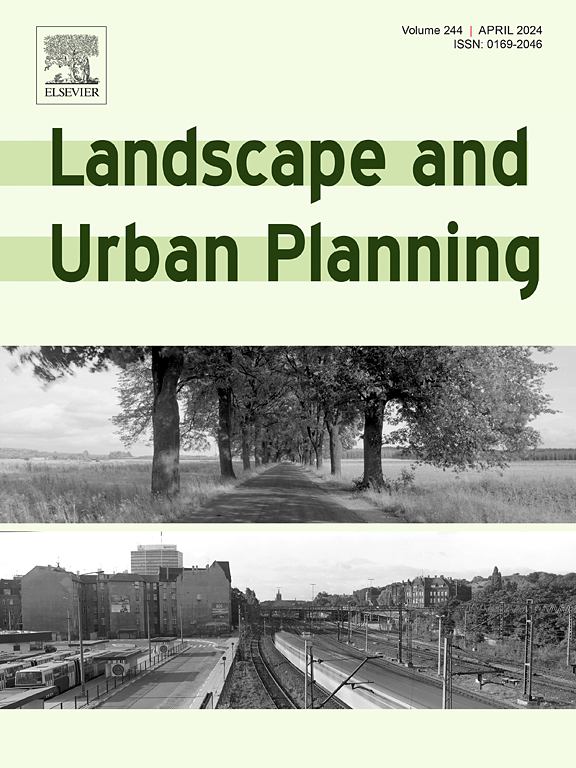探索城市植被类型和防御空间在加州野火驱动事件中建筑损失中的作用
IF 9.2
1区 环境科学与生态学
Q1 ECOLOGY
引用次数: 0
摘要
在野火中,建筑特征和生存的作用得到了很好的研究。城市植被类型、条件和位置对火灾中建筑物损失的影响较小。在以灌木和森林为主的城市生态系统中,我们绘制并统计模拟了不同防御空间缓冲带(dsb)的城市植被特征及其在预测建筑损失中的作用。利用3.0 m分辨率的PlanetScope图像、地理空间数据和认知技术,我们绘制了美国加利福尼亚州文图拉和天堂市受火灾影响社区的包尺度植被类型和建筑特征。分类回归树根据3种不同的dsb预测了2个不同生态区的建筑损失。urban-chaparral模型预测,在距离建筑物0-2 m的DSBs中,较高的裸地覆盖和较高的含水率树木是建筑物存活的重要预测因子。而在距离建筑物10-20 m的DSBs中,裸露地百分比、到草本植物的距离、建筑物密度和树木距离是建筑物损失的预测因子。城市森林模型预测的裸地百分比、到裸地的距离和草本盖度是建筑物损失的显著预测因子,而悬垂树木盖度百分比对小于2 m的dsb建筑物损失的预测影响较小。在距离建筑物2 ~ 10 m的区域内,较低的灌木和乔木湿度和建筑物密度是建筑物损失的最重要预测因子;而在距离建筑物10 ~ 20 m的dsb中,与散落树木的距离和建筑物密度是显著的预测因子。研究结果可用于了解与植被有关的利益和火灾危险之间的权衡,并用于制定家庭保险和市政条例要求。本文章由计算机程序翻译,如有差异,请以英文原文为准。
Exploring urban vegetation type and defensible space’s role in building loss during wildfire-driven events in California
The role of building characteristics and survival during wildfires are well studied. Less so is the role of urban vegetation type, condition, and location on building loss in fire events. We mapped and statistically modeled parcel-scale urban vegetation characteristics across different Defensible Space Buffers (DSBs) and their role in predicting building loss in shrub and forest dominated urban ecosystems. Using 3.0 m resolution PlanetScope imagery, geospatial data, and eCognition we mapped parcel-scale vegetation types and building characteristics in fire affected neighborhoods in Ventura and Paradise, California US. Classification and Regression Trees predicted building loss according to three different DSBs in two different ecoregions. An urban-chaparral model predicted higher bare ground cover and higher moisture content trees were significant predictors of building survival in DSBs 0–2 m from buildings. While in DSBs 10–20 m from buildings, percent bare ground, distance to herbaceous, building density, and tree distance were predictors of building loss. The urban-forest model predicted percent bare ground, distance to bare ground and herbaceous cover were significant predictors of buildings loss, while percent overhanging tree cover was less influential in predicting in building loss in DSBs less than 2 m. In DSBs 2–10 m from buildings, low shrub and tree moisture, and building densities were the most important predictors of building loss; while distance to scattered trees and building density were significant predictors in DSBs 10–20 m from buildings. Results can be used to understand the tradeoffs between vegetation-related benefits and fire hazard and for developing home insurance and municipal ordinance requirements.
求助全文
通过发布文献求助,成功后即可免费获取论文全文。
去求助
来源期刊

Landscape and Urban Planning
环境科学-生态学
CiteScore
15.20
自引率
6.60%
发文量
232
审稿时长
6 months
期刊介绍:
Landscape and Urban Planning is an international journal that aims to enhance our understanding of landscapes and promote sustainable solutions for landscape change. The journal focuses on landscapes as complex social-ecological systems that encompass various spatial and temporal dimensions. These landscapes possess aesthetic, natural, and cultural qualities that are valued by individuals in different ways, leading to actions that alter the landscape. With increasing urbanization and the need for ecological and cultural sensitivity at various scales, a multidisciplinary approach is necessary to comprehend and align social and ecological values for landscape sustainability. The journal believes that combining landscape science with planning and design can yield positive outcomes for both people and nature.
 求助内容:
求助内容: 应助结果提醒方式:
应助结果提醒方式:


